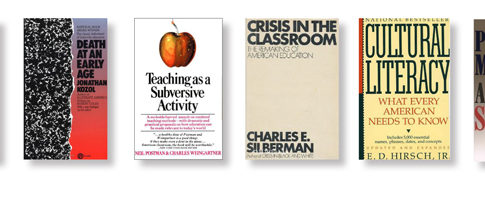 Teach Like a Champion: 49 Techniques That Put Students on the Path to College
Teach Like a Champion: 49 Techniques That Put Students on the Path to College
By Doug Lemov
Jossey-Bass, 2010, $27.95; 352 pages.
The first five words of Doug Lemov’s book Teach Like a Champion are “Great teaching is an art.” This is not a promising start.
Over 3 million women and men stand in front of classrooms every day in the U.S. It is too much to hope for, and always will be, that more than a small percentage of them will be artists, great, bad or mediocre. The degree to which we pin our hopes for large-scale school improvement on attracting artists and rock stars to the classroom is the degree to which we plan to fail.
Yet all is not lost. After dispensing with five poorly chosen words, Lemov spends the next 300 pages completely contradicting them, demonstrating in convincing detail that teaching is not an art at all, but a craft, a series of techniques that can be identified, learned, practiced, and perfected. His focused, obsessively practical study of what makes teachers effective could—and should—shift the terms of our increasingly vitriolic national debate from “teacher quality” to “quality teaching.” This is no mere semantic distinction. The difference is not who is in the front of the room. The difference is what that person does. Lemov’s achievement is to examine teaching at the molecular level. By doing so, he may have rescued education reform from its implicit dependence on classroom saints and superheroes. It is an indispensable shift. If teaching effectively is something for the best and the brightest, rather than the merely dedicated and diligent, education reform is finished, now and forever.
“Many of the techniques you will read about in this book at first may seem mundane, unremarkable, even disappointing,” Lemov begins apologetically. Don’t be fooled by his modesty. The managing director of Uncommon Schools, a network of successful charter schools in New York and New Jersey, Lemov has invested thousands of hours in classroom observations, work that has made him a sought-after consultant to ed reform icons such as KIPP, New Leaders for New Schools, Teach For America, and others. Under Lemov’s watchful eye, the subtle magic of solid craftwork is revealed: Stand still when giving directions; ask students who have not raised their hands to answer a question; use “wait time,” a few seconds’ pause after asking a question before calling on a student to answer it. Each technique is intended to improve classroom management, enhance student engagement, raise expectations, and to do so briskly.
Lemov is obsessed with time and the amount of it wasted moving from one place to another, putting materials away, or transitioning to a new lesson or activity. “There isn’t a school of education in the country that would stoop to teach its aspiring teachers how to train their students to pass out papers,” he writes, “even though it is one of the most valuable things they could possibly do.” As Lemov calculates, the time saved on such mundane tasks quickly adds up to days of extra instructional time over a school year.
If Teach Like a Champion fails to become a standard text in our schools of education, however, it will not be a function of the utilitarian thrust of Lemov’s observations, but his refusal to pay even lip service to the standard homilies of effective practice. Guide on the side? Self-directed learning? Lemov favors students in rows as the default classroom structure. Culturally relevant pedagogy? Substitute rap lyrics for lyric poetry? “Content is one of the places that teaching is most vulnerable to assumptions and stereotypes. What does it say,” Lemov asks, “if we assume that students won’t be inspired by books written by authors of other races?” Volumes have been written on differentiated instruction. Lemov gives it a single, not very deferential paragraph. Group work is “as likely to yield discussions of last night’s episode of American Idol as it is higher-order discussions of content.” Asking frequent, targeted, rigorous questions of students, he believes, “is a powerful and much simpler tool for differentiating.”
“One of the biggest ironies I hope you will take away from reading this book is that many of the tools likely to yield the strongest classroom results remain essentially beneath the notice of our theories and theorists of education,” he writes. It is hard not to agree.
At no point in Teach Like a Champion does Lemov explicitly state that his goal is to wipe out the beau ideal of the rock star teacher. He doesn’t need to. If we’re fortunate, it will wither away once Lemov’s taxonomy takes root. In the popular imagination, fueled by Hollywood, hero teachers are charismatic figures, endowed with an unshakable will, and a deep, abiding belief in the untapped genius of their (inevitably) unruly students. Miracle-working mavericks, they defy the forces of mediocrity arrayed against them and magically transform a class full of those kids—the ones the “system” and every other adult in the building—nay, the world—has long since given up on. Good-bye, poverty, gangs, and mean streets. Hello, Harvard. And if one teacher can work such wonders, surely it is not too much to expect them all to do it. The exceptions prove what the rule should be. No excuses. Whatever it takes. Relentless pursuit. What part of “every child can succeed at the highest level” do you not understand?
Readers hoping for stock tales of hero teachers will be disappointed. Teach Like a Champion features many teachers, but they are master craftsmen, not superheroes. Describing grammatically correct complete sentences as “the battering ram that knocks down the door to college” is as close to hyperbole as Lemov gets. He sees high expectations as essential to student achievement, but not an occasion for grandstanding and motivational speeches. Instead, it’s about running a classroom where participation is not optional, standards are clear, and no apologies are made for rigor. Mastering sound teaching techniques “will be far more productive than being firm of convictions, committed to a strategy, and, in the end, beaten by the reality of what lies inside the classroom door in the toughest neighborhoods of our cities and towns,” says Lemov.
Teach Like a Champion is not a perfect book. Its advice is broadly applicable, but its sweet spot is elementary and middle-school teachers in low-performing urban schools. Veteran teachers who work in other settings may wonder what all the fuss is about, and Lemov’s definition of effective teaching as getting big test gains in low-income schools may be too narrow for some.
Still, Uncommon Schools runs 17 charter schools in New York, which as a group outperform state averages in both math and English language arts (ELA). Two of its Brooklyn schools have posted math scores that were the best in the state, Excellence Boys Charter School (6th grade) and Kings Collegiate Charter School (7th grade); ELA test scores of 8th graders at True North Rochester Preparatory Charter School in Rochester placed that school at number 6 out of 1,450 schools tested. While that’s not proof positive of effectiveness, there is an intuitive, even visceral appeal to Lemov’s techniques. Keeping all students engaged and attentive is surely better than failing to do so. There is no conceivable downside to lengthening learning time by wasting less of the school day. Teachers seem not to be waiting for gold-standard research to validate the 49 techniques in Lemov’s taxonomy as effective. Six months after publication, Teach Like a Champion was still a top education book and overall best seller on Amazon.com. Doug Lemov has struck gold, and a nerve.
Seldom has a book been better timed or more urgently needed. Walk into a struggling urban school and you will mostly find well-intentioned people working hard and failing. More often than not, they’re failing despite doing precisely what they’ve been trained to do. The proper question is not how do we get rid of bad teachers, but how can we make our existing teacher corps more effective? Thus, perhaps the highest praise that one can heap on Mr. Lemov’s book is that, for the first time, it makes helping teachers improve their craft on a broad scale seem not merely sensible, but achievable.
A former 5th-grade teacher, Robert Pondiscio writes about education at the Core Knowledge Blog. For his take on Steve Farr’s Teaching as Leadership, see our blog.





